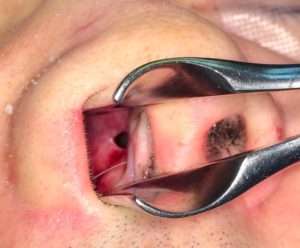
In the June 2018 issue of the journal Plastic and Reconstructive Surgery an article was published entitled ‘Acellular Human Dermal Allograft as a Graft for Nasal Septal Perforation Reconstruction’. In this paper the authors reported on their experience in twelve (12) patients with a to 2 cm septal perforation repair using 1 to 2mm thick sheets of Alloderm as part of their repair. Through an open rhinoplasty approach, bilateral mucoperichondrial flaps were raised including the perforated portion of the septum. On one side the flap was extended enough to be advanced and closed over the perforation. The Alloderm graft was placed into the perforation and secured to the septal edges. Dressings were a silicone sheet covered with plastic nasal splints on each side of the septum.
Their results showed successful closure in 10 out of the 12 patients (83%) as determined by nasal endoscopy. This was confirmed by acoustic rhinometry with a reduction in nasal cross-sectional area of 55%. Nasal symptoms were reduced down to approximately 25% of that before the repair by three months after surgery.
The use of an interpositonal graft in septal perforation repair has a valuable role to play and the use of Alloderm avoids the need to do an autologous harvest. (e.g., temporalis fascia) It is not the main reason that the operation can work as that is the role of providing coverage by mobilized mucoperichondrial flaps. (preferably bilateral flaps on both sides of the perforation) It serves as a backup should one side of the flaps separates and is a surface onto which mucosa can cross over should that occur.
Dr. Barry Eppley
Indianapolis, Indiana


